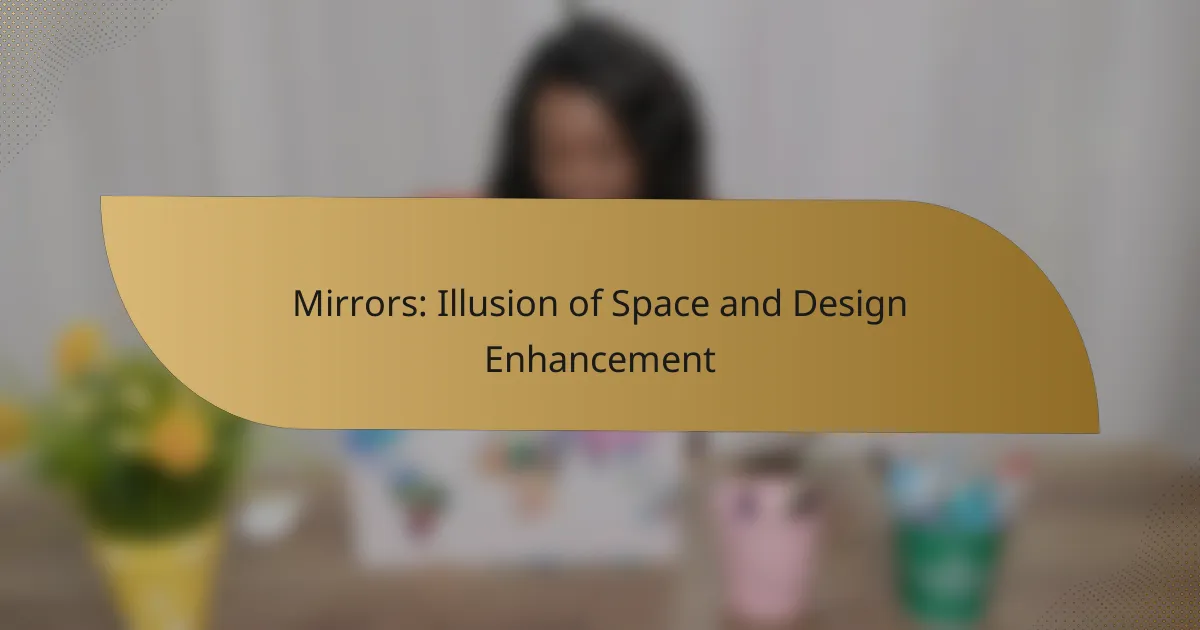Mirrors are powerful tools in interior design, capable of transforming small spaces by creating an illusion of depth and openness. When placed thoughtfully, they enhance light and make areas feel more expansive, contributing to a welcoming atmosphere. Various types of mirrors, such as framed, wall-mounted, and full-length, serve distinct purposes, adding both aesthetic appeal and functionality to any room.

How can mirrors enhance space in small apartments?
Mirrors can significantly enhance the perception of space in small apartments by creating an illusion of depth and openness. By strategically placing mirrors, you can make a compact area feel larger and more inviting.
Visual expansion through placement
To maximize visual expansion, position mirrors across from windows or light sources. This placement allows the mirror to reflect natural light, which can create a sense of depth and openness. Consider using large, floor-to-ceiling mirrors in narrow hallways or small living rooms to amplify the feeling of space.
Another effective strategy is to use mirrored furniture, such as coffee tables or side tables, which can blend into the background while reflecting the surrounding decor. This technique can help maintain a cohesive look while enhancing the overall spaciousness.
Light reflection for brightness
Mirrors are excellent tools for increasing brightness in dimly lit spaces. By reflecting both natural and artificial light, mirrors can brighten up corners and small rooms that might otherwise feel cramped. Positioning mirrors near light fixtures can enhance the illumination in the area.
For optimal results, choose mirrors with a clear, high-quality finish that will effectively bounce light around the room. Avoid overly decorative frames that might detract from the light-reflecting quality of the mirror.
Design cohesion with decor
Incorporating mirrors into your decor can create a unified aesthetic. Choose mirrors that complement your existing color scheme and furniture style to enhance the overall design. For example, a vintage-style mirror can add charm to a rustic apartment, while a sleek, modern mirror suits contemporary decor.
Additionally, consider the shape and size of the mirror in relation to the space. Round mirrors can soften sharp angles, while geometric shapes can add a modern touch. Ensure that the mirror’s design aligns with your apartment’s theme to maintain visual harmony.

What types of mirrors are best for design enhancement?
The best mirrors for design enhancement include framed mirrors, wall-mounted mirrors, and full-length mirrors. Each type serves a unique purpose, contributing to both aesthetics and functionality in various spaces.
Framed mirrors for style
Framed mirrors add a decorative element to any room, serving as focal points that enhance the overall design. They come in various styles, from ornate vintage frames to sleek modern designs, allowing you to match your decor.
When selecting a framed mirror, consider the frame material and color to ensure it complements your existing furnishings. A well-chosen frame can elevate the ambiance of a space, making it feel more cohesive and inviting.
Wall-mounted mirrors for space-saving
Wall-mounted mirrors are ideal for smaller spaces where floor space is limited. These mirrors can be hung at various heights, making them versatile for different room layouts and purposes.
Choose a wall-mounted mirror that fits the scale of your wall and the surrounding decor. Look for options with built-in storage or multi-functional designs to maximize utility without sacrificing style.
Full-length mirrors for functionality
Full-length mirrors are essential for practical use, allowing you to see your entire outfit at a glance. They are particularly useful in bedrooms and dressing areas, enhancing both functionality and style.
When selecting a full-length mirror, consider placement and orientation. A vertical mirror can make a room feel taller, while a horizontal one can create a sense of spaciousness. Ensure the mirror is securely mounted or placed to avoid accidents.

How do mirrors influence interior design trends?
Mirrors play a significant role in shaping interior design trends by creating the illusion of space and enhancing light in a room. Their reflective properties can make small areas appear larger and brighter, influencing how designers approach layout and decor.
Minimalist designs with large mirrors
In minimalist design, large mirrors serve as both functional and aesthetic elements. They can act as statement pieces that reflect light and create a sense of openness, making a room feel more expansive. When choosing a large mirror, consider its placement; positioning it opposite a window can maximize natural light and enhance the airy feel of the space.
To maintain a cohesive look, opt for mirrors with simple frames that complement the minimalist aesthetic. Avoid overly ornate designs, as they can detract from the clean lines and uncluttered feel typical of minimalist interiors.
Vintage mirrors as focal points
Vintage mirrors can serve as captivating focal points in various interior styles, adding character and charm. Their unique frames and historical designs can draw attention and serve as conversation starters. When incorporating vintage mirrors, consider the overall color palette and style of the room to ensure harmony.
To effectively use vintage mirrors, place them in areas where they can reflect interesting views or artwork. This not only enhances their visual appeal but also contributes to the overall design narrative of the space. Be mindful of scale; a large vintage mirror can dominate a small room, while smaller mirrors can be grouped for a layered effect.

What are the best practices for mirror placement?
Effective mirror placement can enhance the perception of space and improve lighting in a room. Key practices include positioning mirrors to reflect natural light and placing them strategically near entryways to create a sense of depth.
Opposite windows for natural light
Placing mirrors opposite windows allows them to reflect natural light, brightening the room and making it feel more spacious. This technique works best in areas where sunlight is abundant, such as living rooms or dining areas.
Consider the size of the mirror; larger mirrors can capture more light and create a more significant impact. Avoid placing mirrors in areas where they may reflect clutter or undesirable views, as this can detract from the intended effect.
Near entryways for depth perception
Positioning mirrors near entryways can enhance depth perception, making small spaces feel larger and more inviting. A well-placed mirror can create an illusion of extended space, which is particularly beneficial in narrow hallways or small foyers.
When selecting a mirror for an entryway, opt for styles that complement the overall decor while ensuring they are functional. Avoid placing mirrors directly facing the door, as this can create a feeling of unease for some people entering the space.

How do mirrors affect room ambiance?
Mirrors significantly influence room ambiance by altering perceptions of space and light. They can create an illusion of depth, making areas feel larger and more inviting.
Creating a sense of openness
Using mirrors strategically can enhance the feeling of openness in a room. Placing a large mirror opposite a window can reflect natural light, brightening the space and making it feel more expansive.
Consider the layout of your furniture; mirrors should be positioned to reflect views that contribute positively to the room’s atmosphere. Avoid placing mirrors where they reflect clutter or dark corners, as this can detract from the desired openness.
Enhancing color and texture
Mirrors can amplify the colors and textures present in a room, adding depth and vibrancy. When positioned correctly, they can reflect artwork, textiles, and decorative elements, enriching the overall aesthetic.
To maximize this effect, choose mirrors with interesting frames that complement your decor style. Additionally, consider using multiple smaller mirrors to create a dynamic visual experience, enhancing various colors and textures throughout the space.

What are the considerations for mirror maintenance?
Maintaining mirrors involves regular cleaning and careful handling to preserve their clarity and finish. Key considerations include the type of cleaning products used, the frequency of cleaning, and the methods employed to avoid scratches or damage.
Cleaning techniques for clarity
To ensure mirrors remain clear and free of streaks, use a soft, lint-free cloth or microfiber towel. Avoid abrasive materials that can scratch the surface. For cleaning solutions, a mix of water and vinegar or a dedicated glass cleaner works effectively without leaving residue.
When cleaning, spray the solution onto the cloth rather than directly onto the mirror to prevent excess liquid from seeping into the edges, which can damage the backing. Wipe in a circular motion to lift dirt and smudges, and finish with a dry section of the cloth for a streak-free shine.
Regular maintenance should be done every few weeks, but mirrors in high-traffic areas may require more frequent cleaning. Always check for signs of wear or damage, and address any issues promptly to maintain their aesthetic appeal and functionality.
